Fatigue and Fracture Evaluations in Ti-10V-2Fe-3Al (Ti 10-2-3)
Abstract
:1. Introduction
2. Materials and Methods
3. Results
4. Discussion
5. Conclusions
Funding
Data Availability Statement
Acknowledgments
Conflicts of Interest
References
- Boyer, R.R.; Slattery, K.T.; Chellman, D.J.; Phelps, H.R. Recent Titanium Developments and Applications in the Aerospace Industry. In Ti-2007 Science and Technology; Ninomi, M., Akiyama, S., Ikeda, M., Hagiwara, M., Maruyama, K., Eds.; The Japan Institute of Metals: Sendai, Japan, 2007; pp. 1255–1262. [Google Scholar]
- Boyer, R.R. Design properties of a high strength titanium alloy, Ti-10V-2Fe-3Al. J. Met. March 1980, 32, 61–65. [Google Scholar] [CrossRef]
- Jha, S.K.; Ravichandran, K.S. Effect of mean stress (stress ratio) and aging on fatigue-crack growth in a metastable beta titanium alloy, Ti-10V-2Fe-3Al. Metall. Mater. Trans. A 2000, 31, 703–714. [Google Scholar] [CrossRef]
- Terlinde, G.; Fischer, G. Beta Titanium Alloys. In Titanium and Titanium Alloys: Fundamentals and Applications; Leyens, C., Peters, M., Eds.; Wiley-VCH Verlag GmbH & Co. KGaA: Weinheim, Germany, 2003; pp. 37–57. [Google Scholar]
- Cotton, J.D.; Briggs, R.D.; Boyer, R.R.; Tamirisakandala, S.; Russo, P.; Shchetnikov, N.; Fanning, J.C. State of the Art in Beta Titanium Alloys for Airframe Applications. JOM 2015, 67, 1281–1303. [Google Scholar] [CrossRef]
- Aerospace Material Specification AMS4984; Titanium Alloy Forgings 10V-2Fe-3Al Consumable Electrode Melted, Solution Heat Treated and Aged 173,000 psi (1195 MPa) Tensile Strength. SAE International: Warrendale, PA, USA, 1987.
- Aerospace Material Specification AMS4987; Titanium Alloy, Forgings 10V-2Fe-3AI Consumable Electrode Melted, Single-Step Solution Heat Treated and Overaged 140 ksi (965 MPa) Tensile Strength. SAE International: Warrendale, PA, USA, 1995.
- Timetal 10-2-3; Data Sheet. Timet: Birmingham, UK, 2000.
- BS3518-1:1993; Methods of Fatigue Testing. British Standards Institution: London, UK, 1993.
- Mom, A.J.A. Revised Working Document for the AGARD co-Operative Test Programme on Titanium Alloy Engine Material; Technical Report TR 86019L; National Aerospace Laboratory (NLR): Amsterdam, The Netherlands, 1986. [Google Scholar]
- Pickard, A.C. The application of 3-dimensional finite element methods to fracture mechanics and fatigue life prediction. In Engineering Materials Advisory Service; Chameleon Press: London, UK, 1986. [Google Scholar]
- Spence, S.H.; Evans, W.J.; Nicholas, P.J. The Growth of Microstructurally Small Cracks in a Near Alpha Titanium Alloy. In Fracture of Engineering Materials and Structures; Teoh, S.H., Lee, K.H., Eds.; Springer: Dordrecht, The Netherlands, 1991. [Google Scholar]
- ASTM B117; Standard Method of Salt Spray (Fog) Testing. ASTM: West Conshohocken, PA, USA, 2011.
- Vasudevan, A.K.; Ricker, R.E.; Miller, A.C.; Kujawski, D. Fatigue crack tip corrosion processes and oxide induced closure. Mater. Sci. Eng. A 2022, 861, 144383. [Google Scholar] [CrossRef]
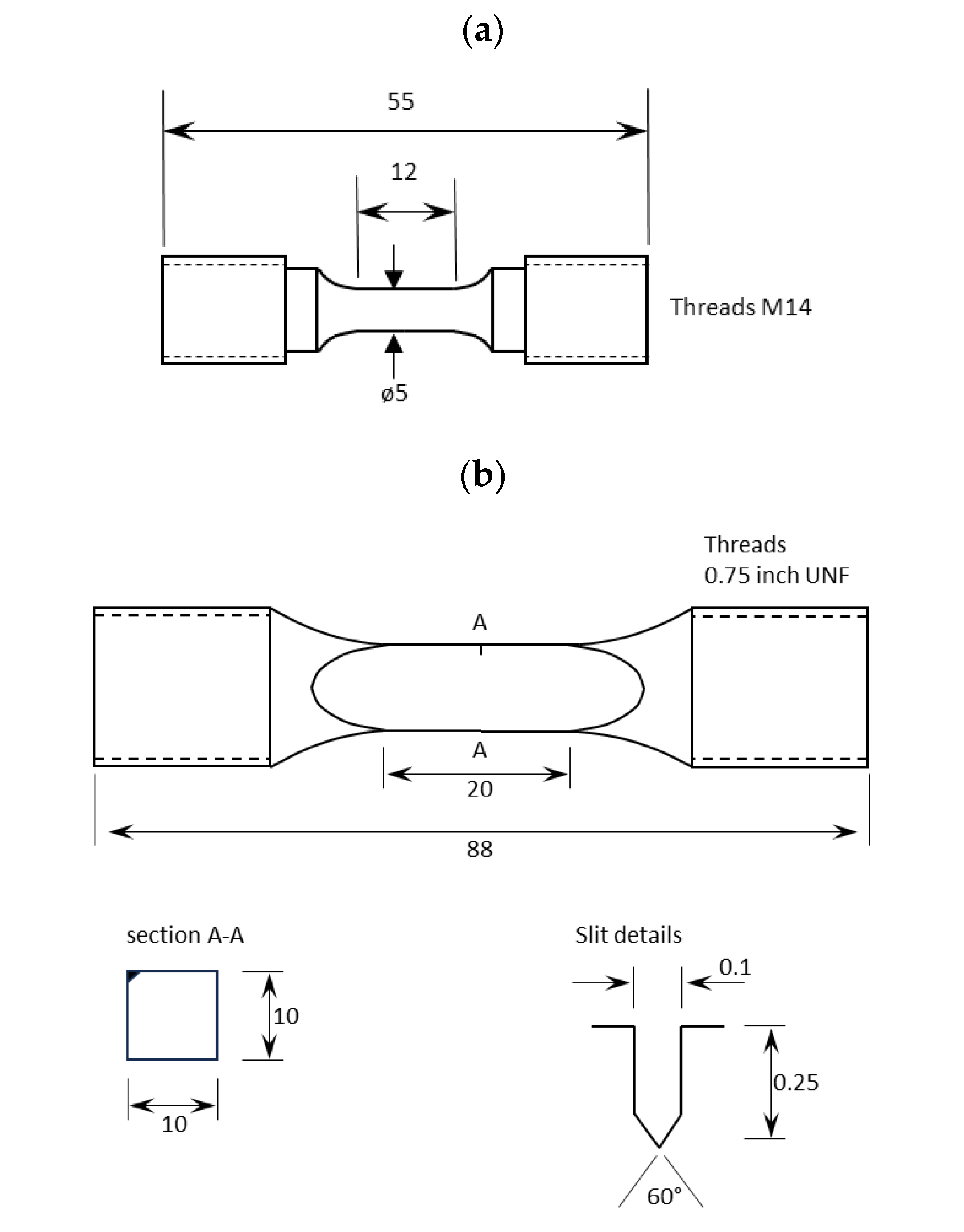
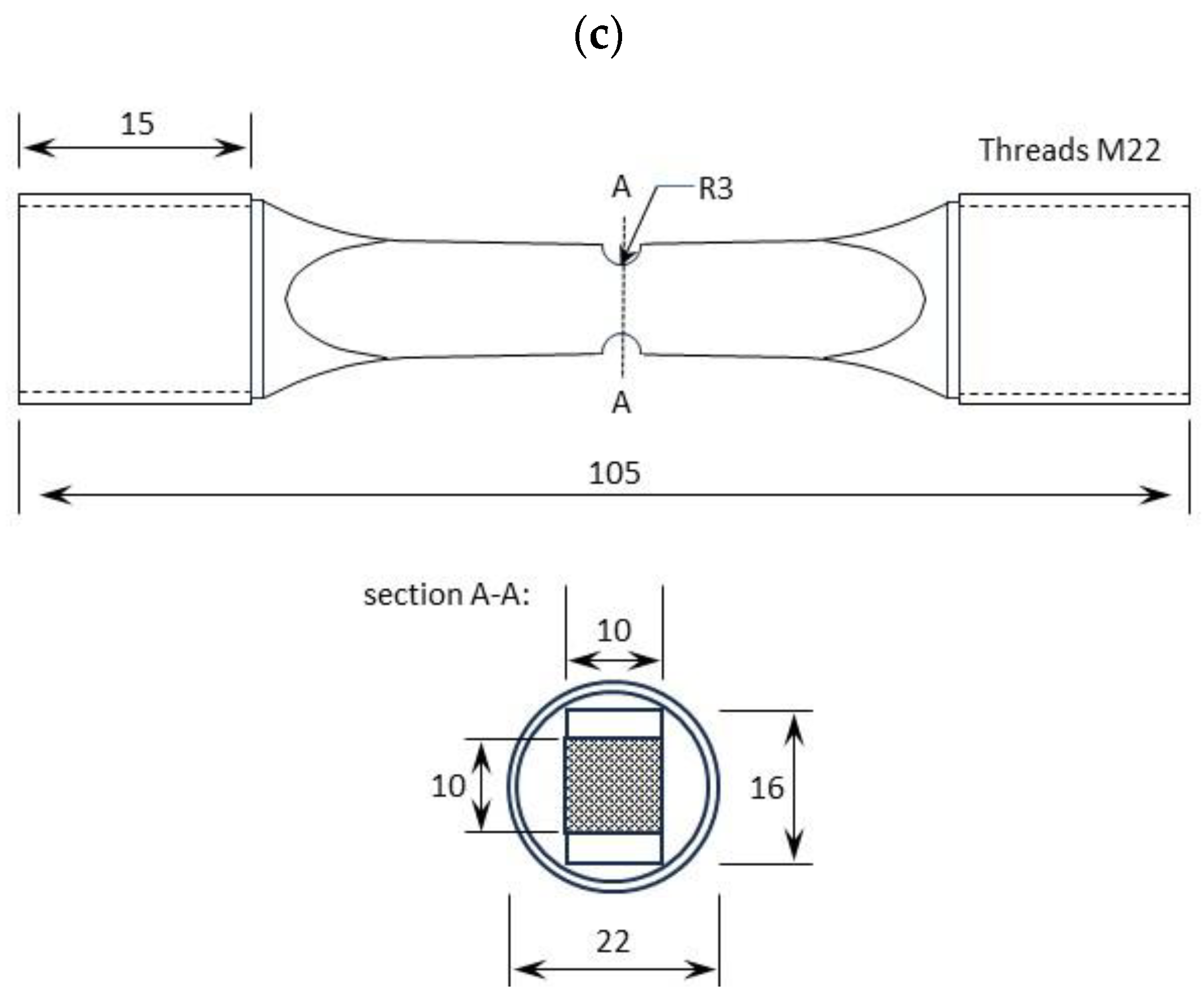
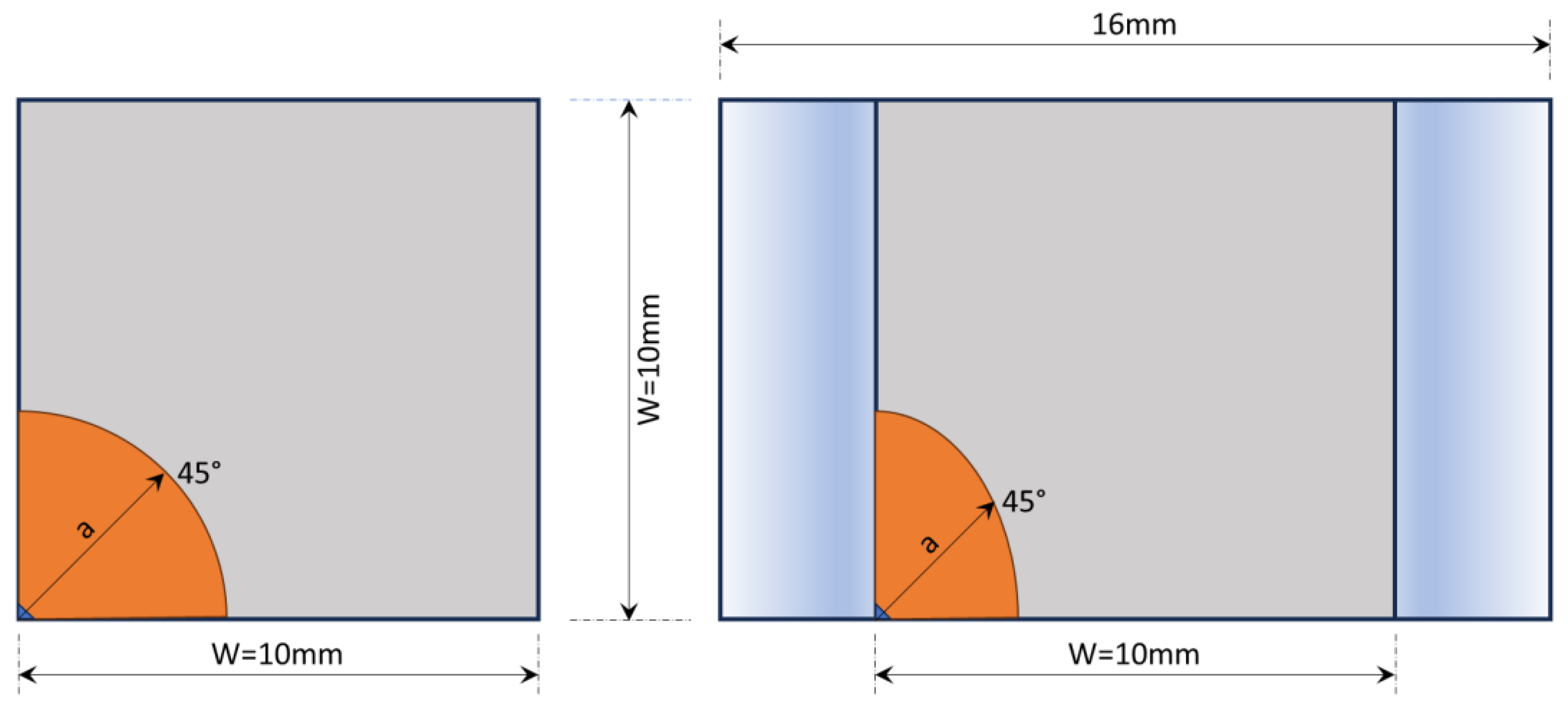
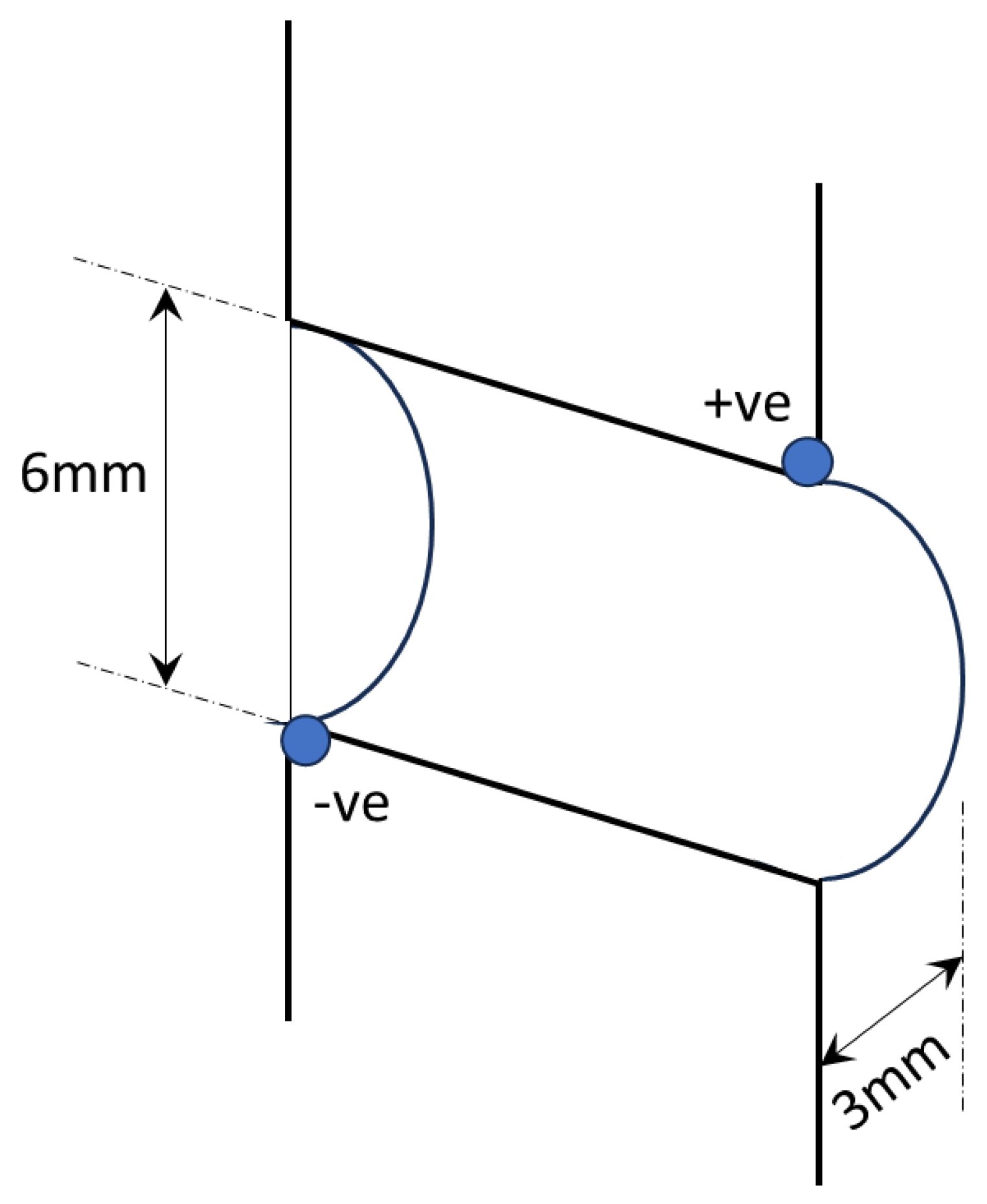
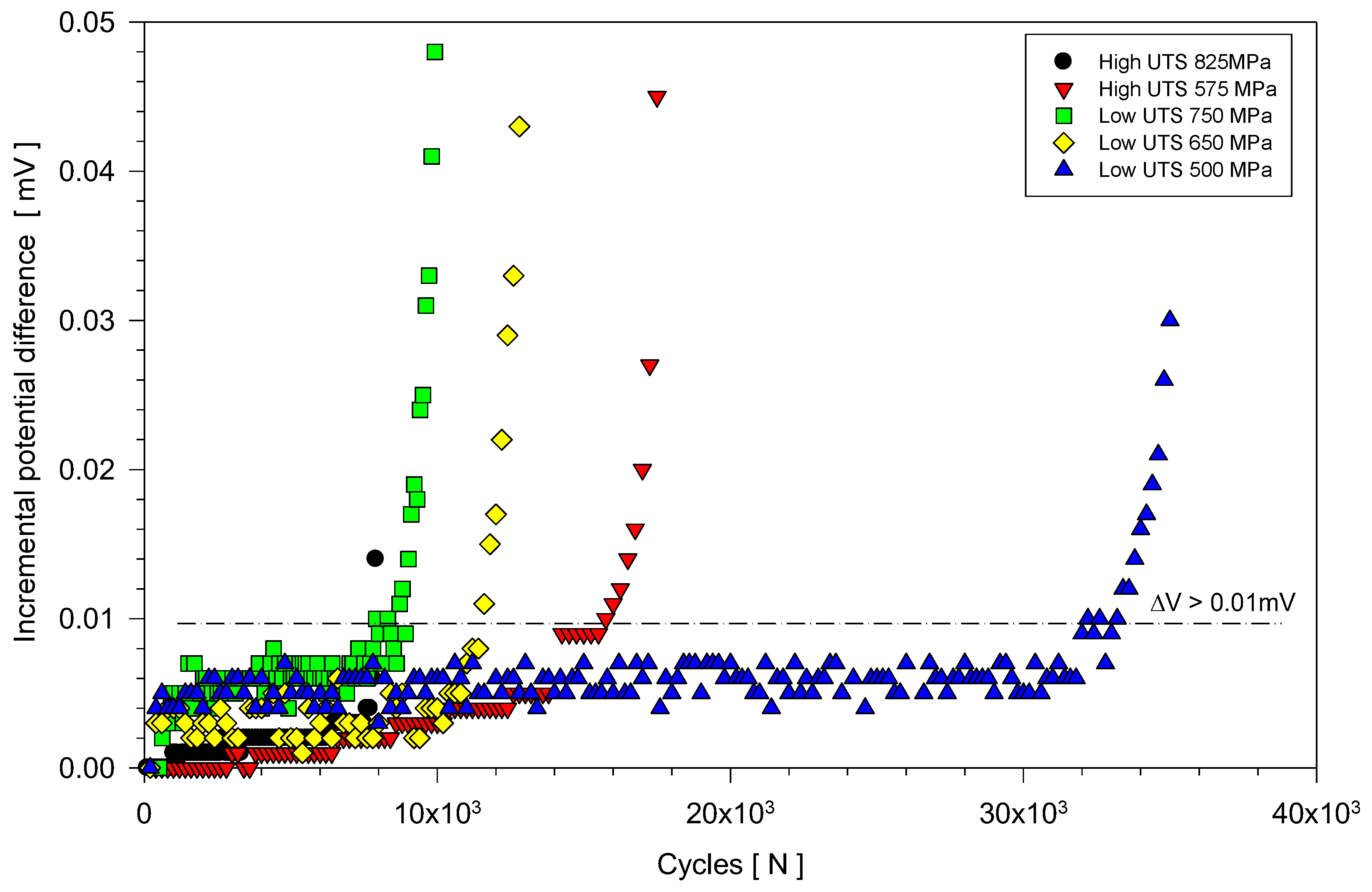
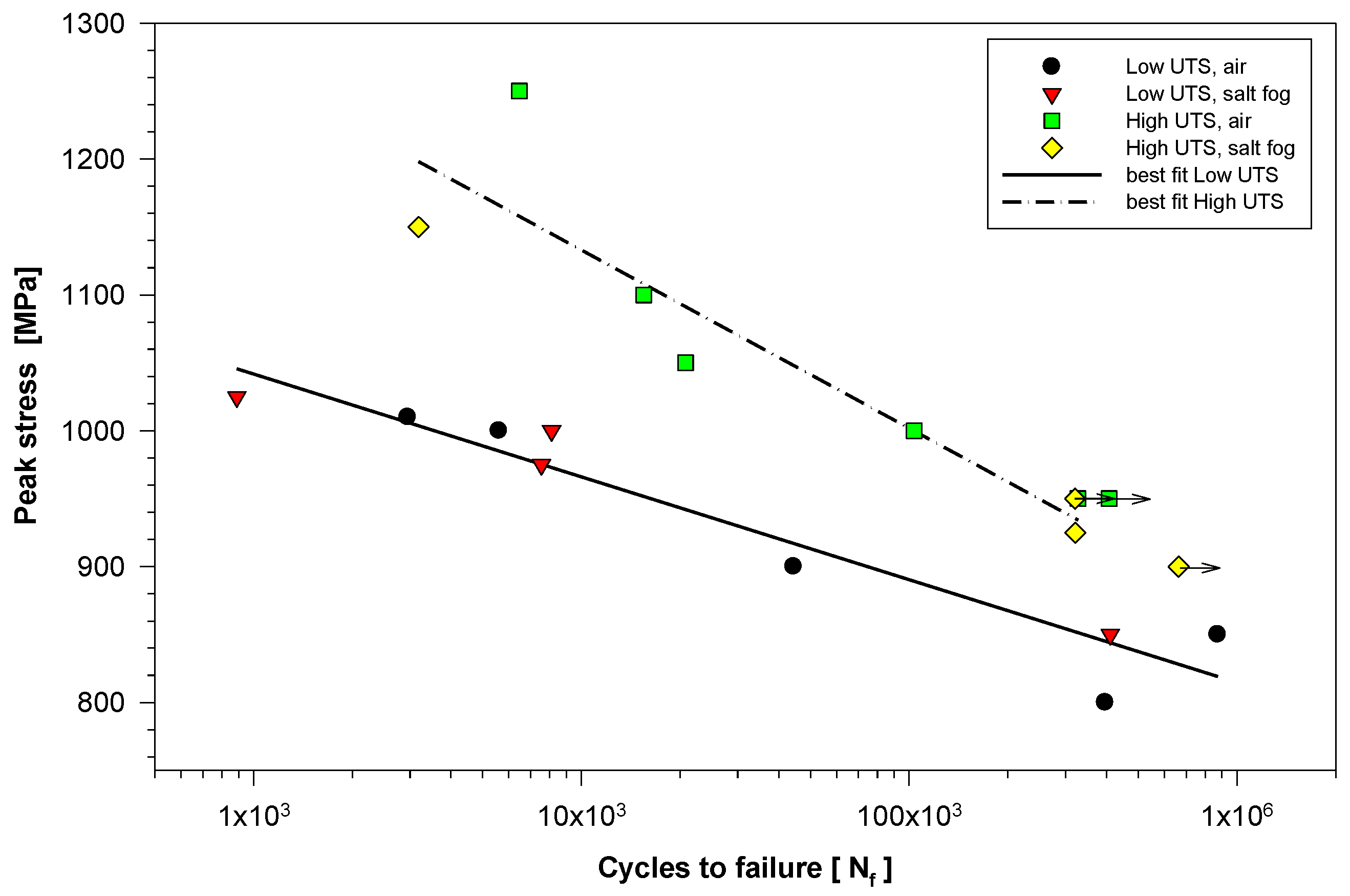
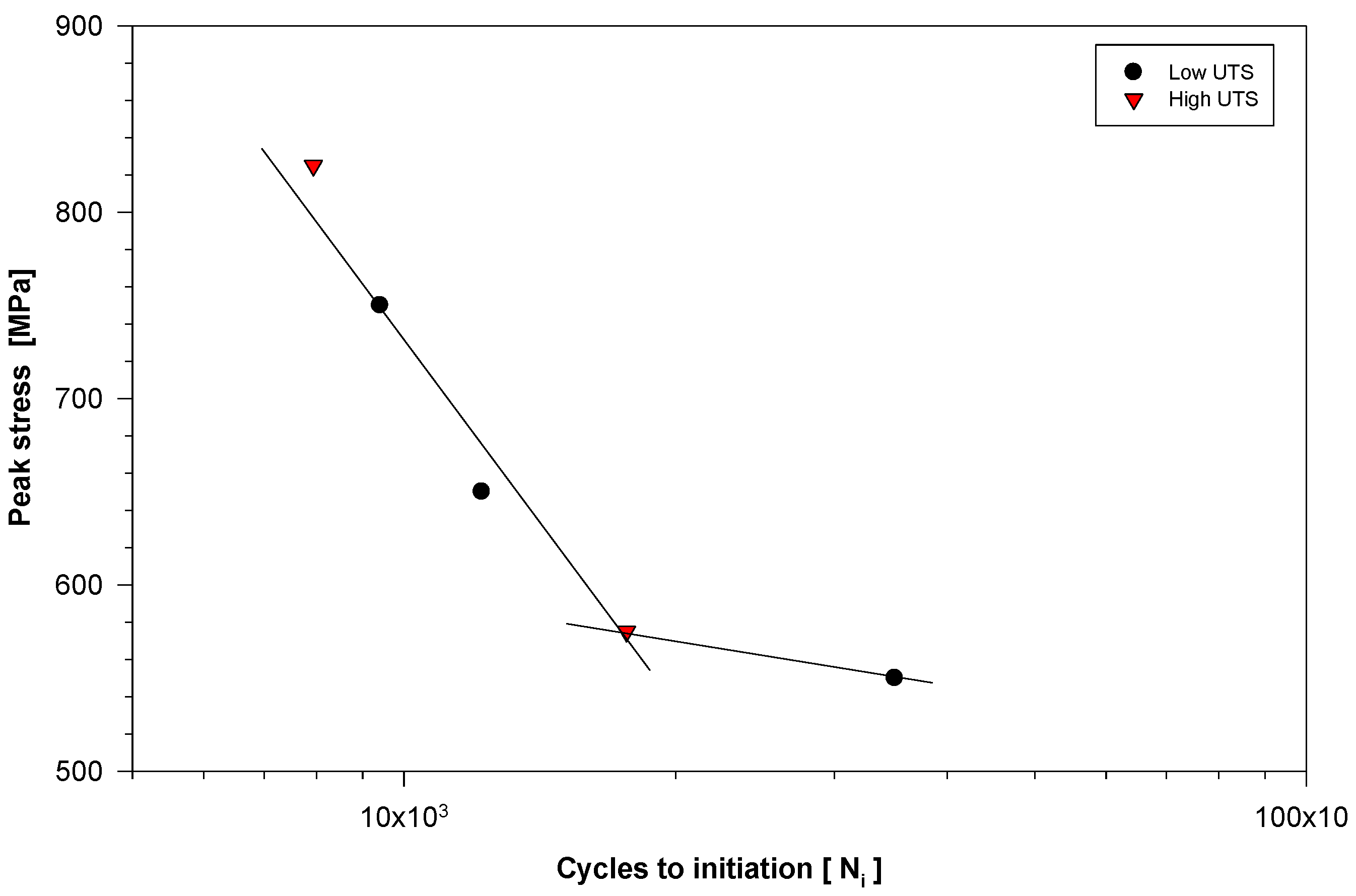
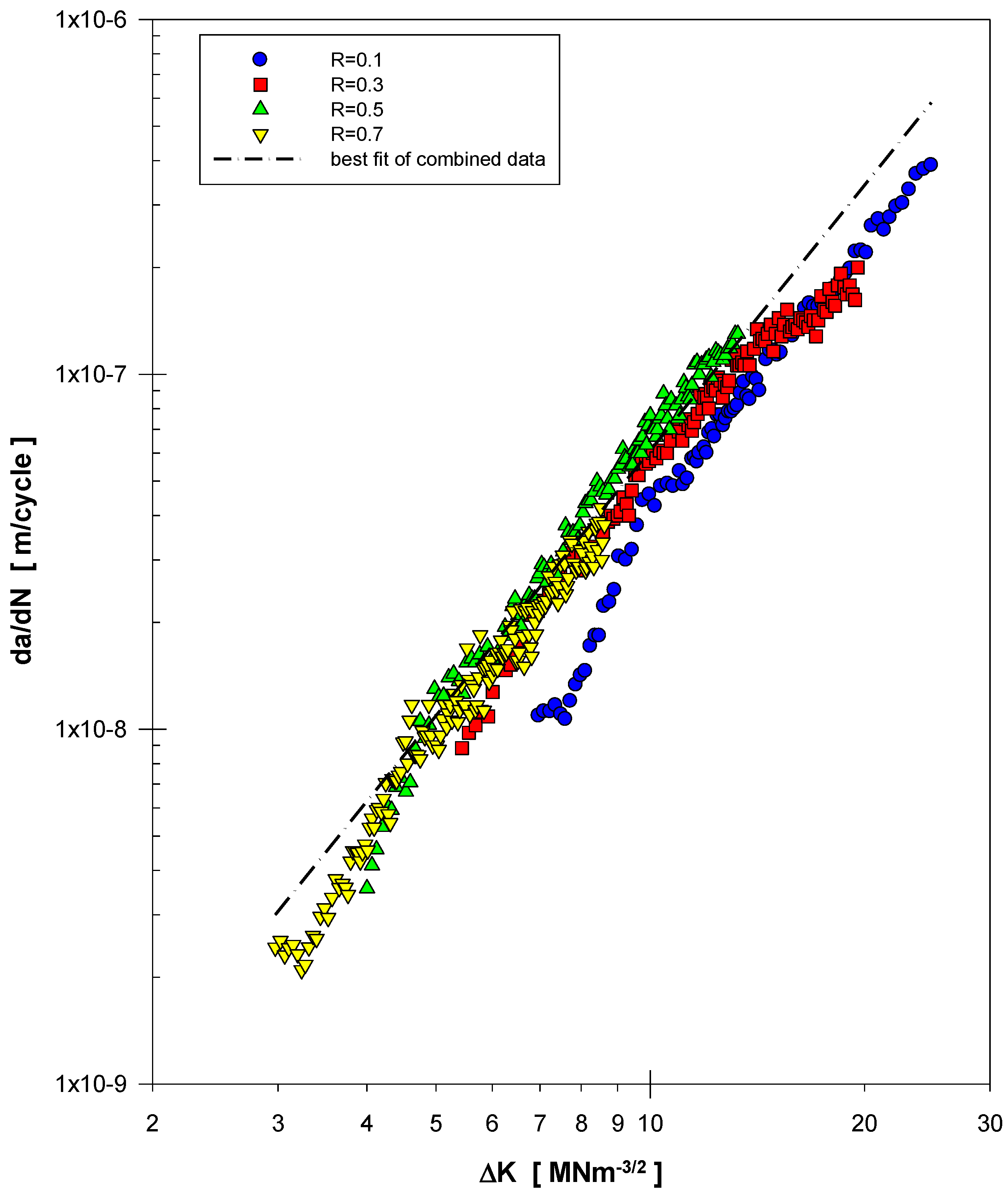
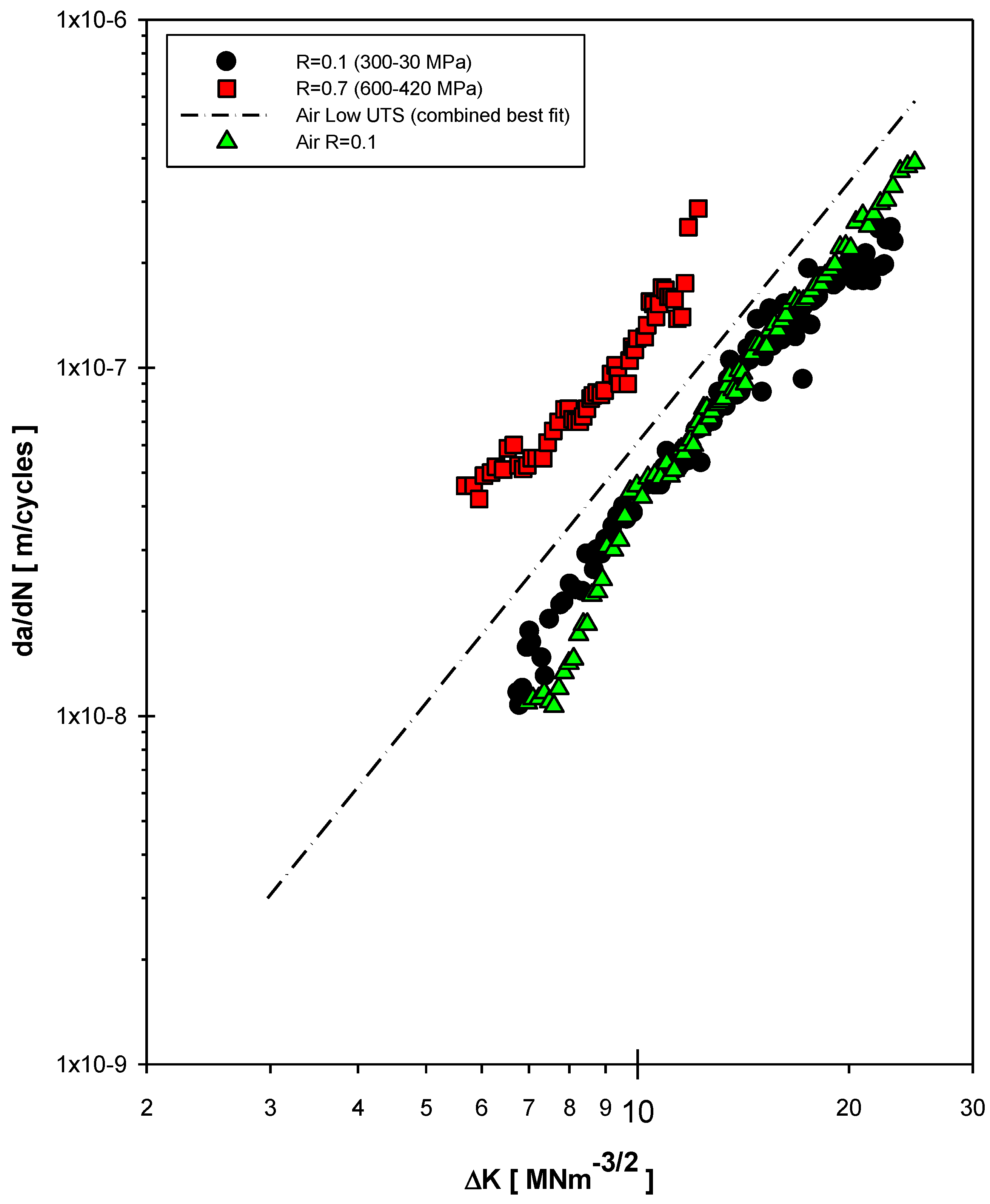
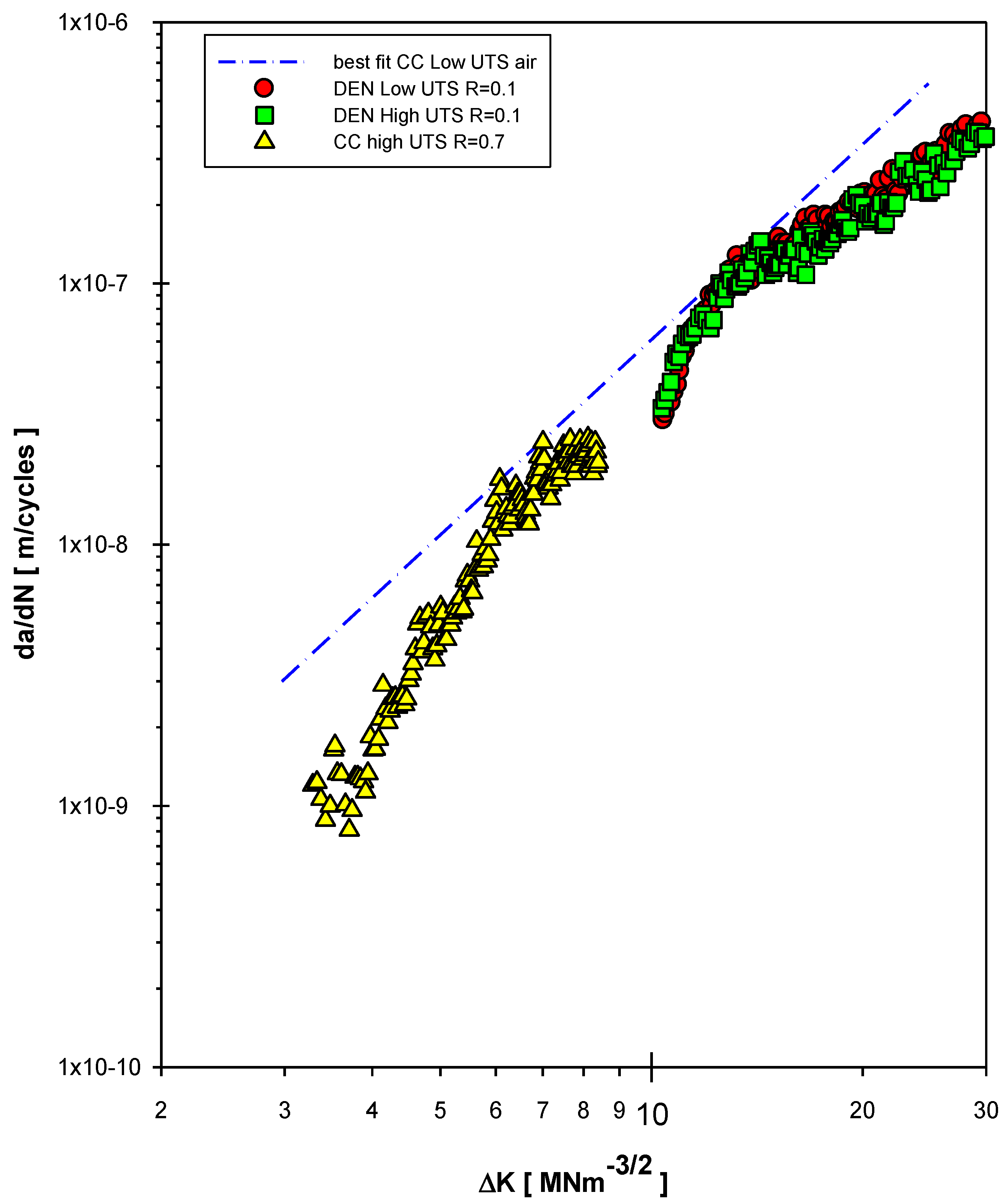
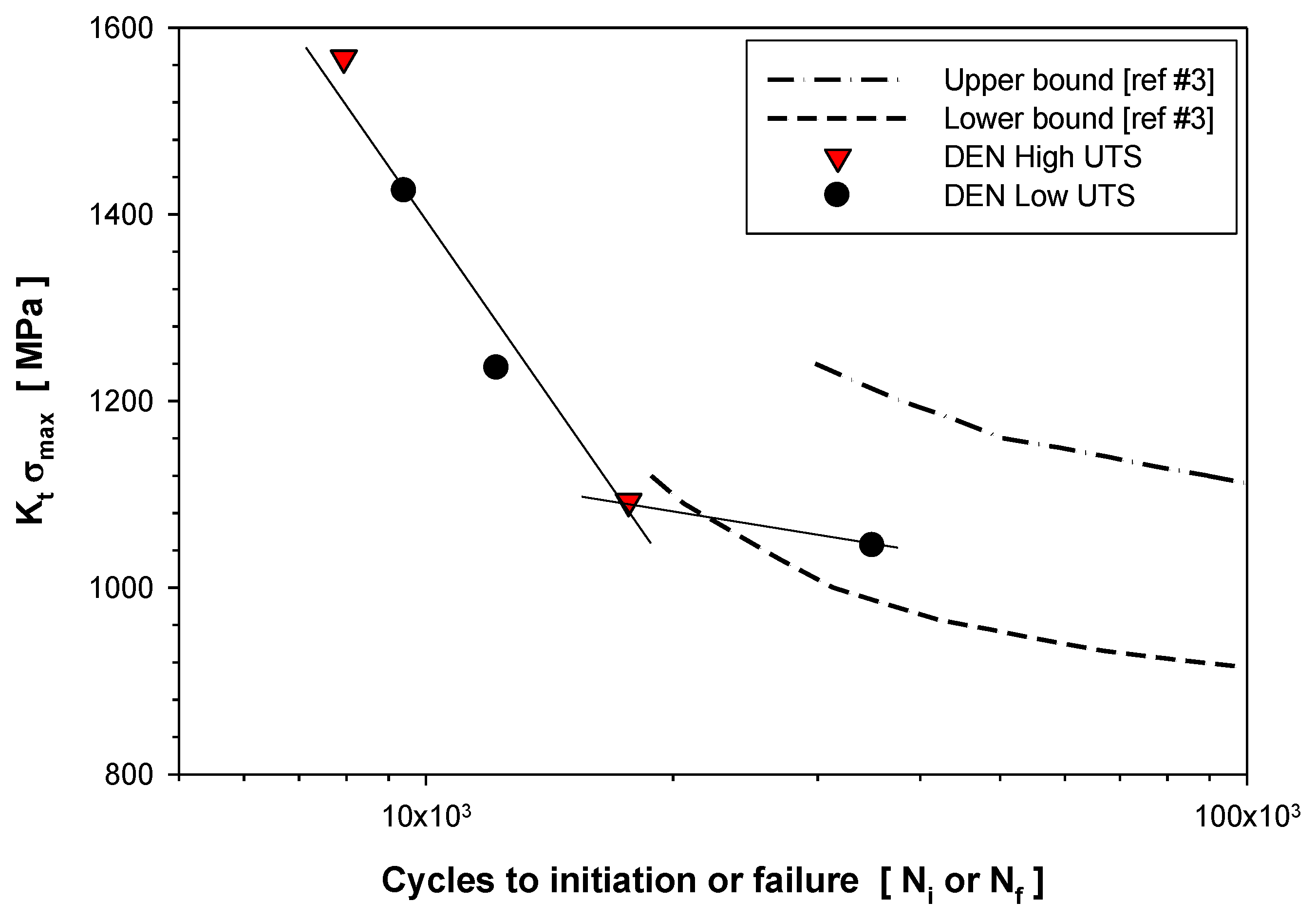
| Peak Stress [MPa] | Cycles to Failure [Nf] | Peak Stress [MPa] | Cycles to Failure [Nf] |
|---|---|---|---|
| Air | |||
| Low UTS | High UTS | ||
| 800 | 396,378 | 950 | 327,678 |
| 850 | 873,220 | 950 | 407,025 * |
| 900 | 44,438 | 1000 | 103,539 |
| 1000 | 5607 | 1050 | 20,788 |
| 1010 | 2954 | 1100 | 15,494 |
| 1050 | 20 | 1250 | 6464 |
| Salt Fog | |||
| Low UTS | High UTS | ||
| 850 | 410,596 | 900 | 663,329 * |
| 975 | 7552 | 925 | 321,027 * |
| 1000 | 8109 | 950 | 320,847 |
| 1025 | 889 | 1150 | 3188 |
| Peak Stress [MPa] | Cycles to Initiation [Ni] | Peak Stress [MPa] | Cycles to Initiation [Ni] |
|---|---|---|---|
| Air | |||
| Low UTS | High UTS | ||
| 550 | 35,000 | 575 | 17,644 |
| 650 | 12,200 | 825 | 7936 |
| 750 | 9413 |
| R Ratio | C [m/cycle] | m | ΔKmin [MNm−3/2] | ΔKmax [MNm−3/2] |
|---|---|---|---|---|
| Air | ||||
| 0.1 | 4 × 10−11 | 3.00 | 6.97 | 24.82 |
| 0.3 | 2 × 10−10 | 2.46 | 5.44 | 19.56 |
| 0.5 | 8 × 10−11 | 3.02 | 4.00 | 13.28 |
| 0.7 | 2 × 10−10 | 2.54 | 2.97 | 8.62 |
| Combined air data | 2 × 10−10 | 2.48 | 2.97 | 24.82 |
| Salt Fog | ||||
| 0.1 | 2 × 10−10 | 2.36 | 6.76 | 23.20 |
| 0.7 | 1 × 10−9 | 2.04 | 5.68 | 12.20 |
Disclaimer/Publisher’s Note: The statements, opinions and data contained in all publications are solely those of the individual author(s) and contributor(s) and not of MDPI and/or the editor(s). MDPI and/or the editor(s) disclaim responsibility for any injury to people or property resulting from any ideas, methods, instructions or products referred to in the content. |
© 2023 by the author. Licensee MDPI, Basel, Switzerland. This article is an open access article distributed under the terms and conditions of the Creative Commons Attribution (CC BY) license (https://creativecommons.org/licenses/by/4.0/).
Share and Cite
Bache, M. Fatigue and Fracture Evaluations in Ti-10V-2Fe-3Al (Ti 10-2-3). Metals 2023, 13, 1986. https://doi.org/10.3390/met13121986
Bache M. Fatigue and Fracture Evaluations in Ti-10V-2Fe-3Al (Ti 10-2-3). Metals. 2023; 13(12):1986. https://doi.org/10.3390/met13121986
Chicago/Turabian StyleBache, Martin. 2023. "Fatigue and Fracture Evaluations in Ti-10V-2Fe-3Al (Ti 10-2-3)" Metals 13, no. 12: 1986. https://doi.org/10.3390/met13121986







